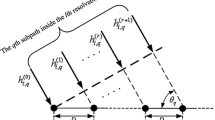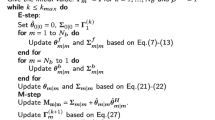Abstract
To achieve fast and computationally simplified channel estimation, we propose a maximum likelihood estimation (MLE) based “diagonal matrix approximation” (DMA) scheme which provides an effective solution to overcome the conflict between estimation accuracy, acquisition time, and complexity. Together with over sampling, the proposed scheme exhibits a performance approaching the Cramér-Rao Lower Bound (CRLB), while keeping computational complexity linear to the signal dimensions. The DMA scheme can still perform well even when the sample estimate of the covariance matrix, due to insufficient number of observation samples, is singular. Therefore, the proposed scheme is a viable solution for fast channel estimation.
Similar content being viewed by others
References
M. Honig, U. Madhow and S. Verdu, “Blind Adaptive Multiuser Detection”, IEEE Trans. on Info. Theory, Vol. 41, No. 4, pp. 944–960, 1995.
E.G. Strom, S. Parkvall, S.L. Miller and B.E. Ottersten, “Propagation Delay Estimation in Asynchronous Direct-Sequence Code-Division Multiple Access Systems”, IEEE Trans. on Comm., Vol. 44, No. 1, pp. 84–93, 1996.
T. Ostman and S. Parkvall, “An Improved Music Algorithm for Estimation of Time Delays in Asynchronous DS-CDMA Systems”, IEEE Trans. on Comm., Vol. 47, No. 11, pp. 1628–1631, 1999.
N. Missiroli, Y. Guo and S. Barton, “Near-Far Resistant Channel Estimation for CDMA Systems Using the Linear Decorrelating Detector”, IEEE Trans. on Comm., Vol. 48, No. 3, pp. 514–524, 2000.
S.E. Bensley and B. Aazhang, “Maximum-Likelihood Synchronization of a Single User for Code-Division Multiple-Access Communication Systems”, IEEE Trans. on Comm., Vol. 46, No. 3, pp. 392–399, 1998.
M. Pesavento and A. Gershman, “Maximum-Likelihood Direction-of-Arrival Estimation in the Presence of Unknown Nonuniform Noise”, IEEE Trans. on Signal Processing, Vol. 49, No. 7, pp. 1310–1324, 2001.
A. Jakobsson and A.L. Swindlehurst, “A Blind Frequency Domain Method for DS-CDMA Synchronization Using Antenna Arrays”, in Proc. of the Thirty-Second Asilomar Conference on Signals, Systems and Computers, Vol. 2, pp. 1848–1852, 1998.
D. Brillinger, Time Series: Data Analysis and Theory, Holden-Day Inc., San Francisco, 1981.
D.H. Johnson and D.E. Dudgeon, Array Signal Processing: Concepts and Techniques, Prentice Hall, Englewood Cliffs, N.J., 1993.
Author information
Authors and Affiliations
Rights and permissions
About this article
Cite this article
Tang, X., Bar-Ness, Y. Maximum Likelihood Based Channel Delay Estimation with Limited Number of Samples Using Diagonal Matrix Approximation. Wireless Personal Communications 27, 183–194 (2003). https://doi.org/10.1023/B:WIRE.0000010146.60266.4e
Issue Date:
DOI: https://doi.org/10.1023/B:WIRE.0000010146.60266.4e




